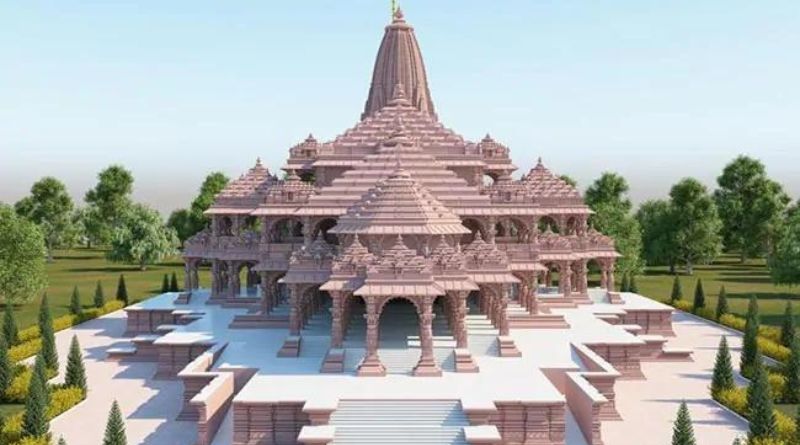
For centuries, the sacred city of Ayodhya, nestled along the banks of the Sarayu River in Uttar Pradesh, India, has echoed with the beats of devotion. At its core stands the Ayodhya Ram Mandir, an awe-inspiring testament to unwavering faith, resilience, and the enduring power of belief. This monumental temple, currently in the throes of construction, transcends being a mere edifice; it encapsulates centuries-old aspirations, serving as a beacon of hope for millions and symbolizing India’s cultural richness.
The narrative of the Ram Mandir is intricately interwoven with the epic Ramayana, a foundational Hindu scripture narrating the life and exploits of Lord Rama, a revered deity regarded as an incarnation of Vishnu. Ayodhya, believed to be Rama’s birthplace, houses the sacred Ram Janmabhoomi site, where the temple now stands, regarded as hallowed ground by Hindus. Through generations, devotees have worshiped here, leaving behind a legacy of steadfast faith and countless stories whispered through time.
The Shadows of Discord: Echoes from History
However, the journey to the present-day Ram Mandir was not solely paved with devotion. The 16th century witnessed the construction of the Babri Masjid on the disputed site, sowing the seeds of tension and sparking a protracted legal and religious conflict. The year 1992 saw the demolition of the Babri Masjid, triggering widespread communal violence and plunging the nation into turmoil. Decades of intricate legal battles ensued, culminating in the landmark Supreme Court verdict of 2019, which awarded the disputed land to a trust tasked with constructing the Ram Mandir.
The Supreme Court’s verdict marked a turning point, opening the doors for the construction of the Ram Mandir and heralding an era of hope and reconciliation. Millions across India rejoiced, interpreting it as a triumph of both faith and justice. The Shri Ram Janmabhoomi Teerth Kshetra Trust, entrusted with overseeing the construction, undertook a monumental task, meticulously planning and executing the creation of this grand temple.
Architectural Brilliance Unveiled: Crafting a Masterpiece
The Ayodhya Ram Mandir is poised to be a marvel of Indian architecture. Drawing inspiration from the traditional nagara style, the temple will be a symphony of intricate carvings, towering pillars, and exquisite domes. Artisans from various corners of the country are painstakingly crafting every detail, ensuring the temple not only showcases architectural prowess but also embodies the essence of India’s spiritual heritage.
More than a religious structure, the Ram Mandir signifies a convergence of faith, cultural pride, and national unity. The construction process itself serves as a symbol of collaboration and inclusivity, with individuals from diverse backgrounds contributing their skills and expertise. The temple aspires to be a beacon of harmony, fostering interfaith dialogue and understanding.
A Timeless Pilgrimage: Experiencing the Ayodhya Ram Mandir
A visit to the Ayodhya Ram Mandir transcends a mere pilgrimage; it unfolds as an immersive experience beyond the constraints of time and space. Approaching the temple complex, the air resonates with anticipation. The intricate carvings on the sandstone walls narrate tales of ancient mythology, while the hymns being chanted infuse the surroundings with serenity. Stepping into the sanctum sanctorum, one is enveloped by a palpable sense of divinity. The idol of Lord Rama, exuding grace and benevolence, evokes profound peace and introspection.
Ayodhya offers more than the grandeur of the Ram Mandir. The city is adorned with numerous temples, ashrams, and ghats, each with its unique story and spiritual significance. Immerse yourself in the sacred waters of the Sarayu River, believed to cleanse sins and bestow blessings. Explore Kanak Bhavan, the former palace of King Dasharatha, Rama’s father. Engage in the vibrant cultural tapestry of Ayodhya, participating in traditional rituals and witnessing the city come alive during festivals like Diwali and Ram Navami.
The Ayodhya Ram Mandir: A Living Testament
The Ayodhya Ram Mandir stands as a living testament to the enduring power of faith, the resilience of the human spirit, and the transformative potential of belief. It represents a symbol of India’s cultural richness, a beacon of hope for millions, and a testament to the nation’s enduring values of unity, harmony, and inclusivity. As the temple takes shape, it promises not only to reshape Ayodhya’s landscape but also to leave an indelible mark on the hearts and minds of people worldwide.
Faith’s Moving Power: The Ram Mandir construction exemplifies the potency of faith and the collective aspirations of millions of devotees.
Reconciliation and Healing: The temple has the potential to foster unity and harmony, bridging divides and promoting understanding.
Cultural Renaissance: Beyond a religious structure, the Ram Mandir symbolizes India’s rich cultural heritage, reigniting interest in art, architecture, and spirituality.
Tourism and Economic Growth: Ayodhya is poised to become a significant pilgrimage destination, attracting devotees globally and boosting local economies.
Symbol of Hope: The Ram Mandir serves as a beacon of hope, embodying the enduring values of faith, resilience, and unity. As it continues to take shape, the temple’s journey reflects the enduring spirit of India and its people.



